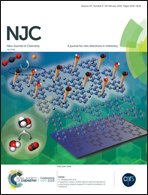Thiophene containing microporous and mesoporous nanoplates for separation of mercury from aqueous solution†
Abstract
Acute toxicity of mercury in food is a challenging problem in the health and environmental sectors which could be addressed by designing robust organic porous materials containing strong mercury chelating sites with high affinity and rapid uptake capacity towards mercury contaminants. Taking the intrinsic advantages of hypercrosslinked polymers, we have developed porous materials having chelating thiophene units in the pore walls. As a proof-of-concept, the bottom-up synthesis approach is used for Friedel–Crafts polymerization of thiophene in making Th-1, Th-2 and Th-3 as representative materials. Among these porous materials, Th-2 exhibits high efficiency in removing mercury from aqueous solution, affording a Hg(II) uptake capacity of 145 mg g−1. The high adsorption capacity renders rapid separation of Hg(II) from aqueous solution, resulting in a concentration well below the acceptable value in drinking water. The impressive performance might be because of the synergistic action between densely packed thiophene sites and rapid diffusion throughout the well-defined micropores and interparticle mesopores. The interaction mechanism between Hg(II) and Th-2 has been established through XPS and FT-IR studies. Overall, we have explored the potential of hypercrosslinked thiophene polymers as scavengers of mercury for the first time and this may be extended for the treatment of mercury contaminated waste water in the future.



 Please wait while we load your content...
Please wait while we load your content...